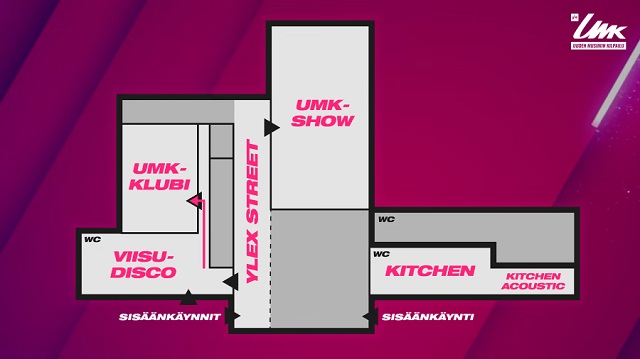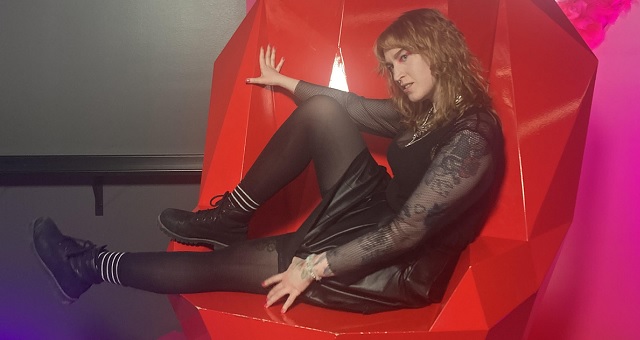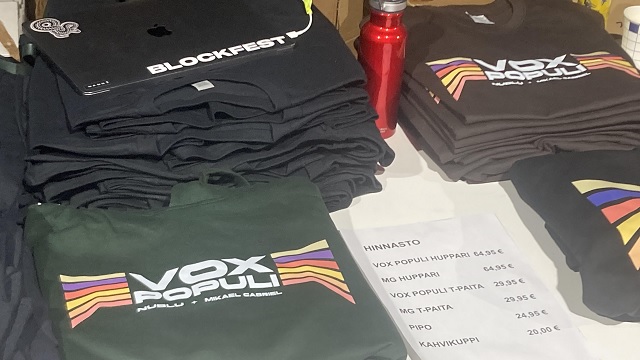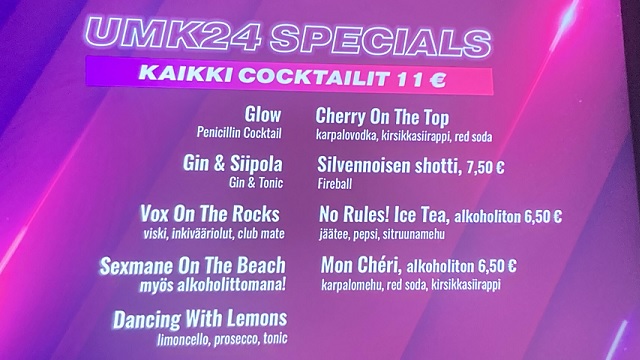The live show at Uuden Musiikin Kilpailu is more than just a live show. Everybody attending can enjoy the two hours inside the arena, three hours of pre-party, and four hours of after-party, all in the same venue.
Last year’s UMK was the first year for this concept, but it made sense last year. The Logomo complex in Turku had multiple rooms, stages, and spaces for cocktail bars and acoustic sets on one side and live performances and DJs on the other.

The floor plan for activities inside of Logomo in Turku at UMK 2023 (Photo: Mika Hokkanen/YLE)
But this year, the size of UMK has increased nearly tenfold, from an audience capacity of 1,500 last year to around 13,000 this year at Finland’s premier venue, the Nokia Arena. Tickets to UMK 2024 in the Nokia Arena ranged from €30 to €80 for the live show and €20 and €30 for the dress rehearsal. They sold out in minutes.
Yet the idea of the pre-party, after-party, and live show all happening at one venue remained the same as part of the ticket package. How on Earth did Yle make this possible?
What Was On Offer
Before the live show, guests could enjoy Eurovision discos on the first and third floors of the Nokia Arena complex and a special bar area reserved for Eurovision karaoke. Furthermore, the 5th floor included the YleX street, a non-Eurovision-themed zone focused on playing commercial hits that would normally be on YleX’s radio station (which aims at a youth audience under 30 years old). Dotted at various points around the arena, you could find lots of hidden surprises from the music videos of UMK acts from this year and yesteryear, so if you wanted to pose like Erika Vikman or straddle Sexmane’s washing machine, you could get the photo op of your dreams here.

Fans posing on the props around the Nokia Arena (Photo: Ben Robertson, ESC Insight)
Furthermore there’s the great highlight of a merch table. I was amazed by this last year in Turku, as the merch wasn’t for the show itself, but for the artists participating in the competition. This year it was expanded to include even the interval acts, and you would be able to buy an Erika Vikman t-shirt, Käärijä drinking mugs and Paskana branded eye masks in the arena. It’s also worth mentioning that, of course, the food and drink stalls in the arena were all open as well, with special areas serving UMK-themed cocktails and Käärijä’s favourite, the Piña Colada.
All attendees were asked to sit in the Nokia Arena thirty minutes before the show started for a warm-up act. This featured a dance troupe bopping away to modern Eurovision classics before a music video montage including Måneskin and Isaac Sene before ending with Lordi counted down the final few minutes before the show started.

Merch was available for all the competing acts in the show, pictured here is what you could get to support Vox Populi in the competition (Photo: Ben Robertson, ESC Insight)
What Is Different About UMK
Of the big arena shows that I have been to, I’d argue that the audience at UMK was perhaps one that most surprised me. It’s notable that the audience is probably the most mixed and blended audience I have ever seen at a Eurovision event. There weren’t so many family groups (it was a 21:00 start local time) but I would look around the audience before, during and after the show and note how it felt like attendees were not only an even gender split but also an even age split, in a world away from what demographics were at Benidorm Fest.
One knock-on effect of this is that before the show there were some quite long queues for the female toilets, the Nokia Arena while being multi-functioning is first and foremost an ice hockey venue and perhaps not used to a balanced crowd. There were also large queues before the show at the drink stations around the arena, with the Finns going big on the it’s crazy, it’s party unofficial tag line of UMK, and queues to get a song on the karaoke station lasted well over an hour at its peak. People weren’t here just for the show, they were here for the experience.

Floor plan for the middle level at the Nokia Arena for UMK 2024 (Photo: Saara Paasikivi, Yle)
If you want to soak in all the pre-show buzz and try out all the fringe events inside the arena, get there early is my advice. This is a crowd that is all out there to have a good time. They do shut down all of the fringe activities in good time before the pre show starts at 20:30. This is because they want everybody in their seats in good time for the live broadcast. I do feel this pre-show, which was mainly just video content of previous entries, wasn’t the best warm up for the crowd. If possible I think it would have been preferable to have more time for the dance troupe, especially in the final minutes before the show, to make sure the crowd were fully pumped for the opening number.
I note that, in contrast to other National Finals that I have been to, there is a balance here between UMK music and Eurovision music being played, both inside the arena in the pre-show but also at the Eurovision disco and around the arena. You will get your Finnish classics, even some from before the UMK era began, diced in with Eurovision tracks that perhaps the locals wouldn’t know (‘Zorra’ got a playing about an hour before the show started).
I did hear some of the Eurovision die-hards comment to me that perhaps they would have appreciated after the show somewhere in the venue with a particularly nerdy taste, somewhere that might throw up a Melfest Semi Finalist or a song that finished 6th in UMK 2014. Perhaps the Finnish branch of OGAE, Europe’s earliest Eurovision club, could assist with such a space in the future.
However, the one thing that really struck me about the culture in Finland was what happened in the arena. The arena experience has a couple of quirks. Firstly, there was a separate section of the arena that was over 18’s only, and this was a part of the arena where fans could purchase alcoholic drinks at the venue and bring them inside the arena. Not that you could necessarily tell which part of the arena was for being more loud or brash than anywhere else because everybody got into it.
While the audience at UMK is fully seated, before each and every performance of the seven competing acts, the entire arena rises to its feet, ready to boogie, cheer, and support each act on stage. There was something almost solemn about this, like rising to your feet at church, which is a viewing culture I have not experienced anywhere else on my National Final travels.
Despite this standing culture however, I don’t think UMK in its current form should have a standing zone in-front of the stage for fans who want to do so. The pace of the show is a touch too slow to keep the energy and excitement up throughout, and the very long postcards contribute to waiting times approaching four minutes between songs. That’s not the environment for a standing audience.
An After-Party Like No Other
I did go to UMK concerned that the venue concourse would not be able to cope with the vast numbers of people up for having a post-show party, but I did not find that to be the case. Yes, the long queues for karaoke were still there, but the venue was, on the whole, easy to walk around and navigate without huge waves of fans everywhere. At no point did the outside space feel overly crowded, which I would attribute to the design of the Nokia Arena.
Arguably, it was too easy, in fact, as no areas of the concourse were shut off, meaning it was easy to move 50 metres around the corner to find a quiet corner to contemplate the evening. Now I love a quiet corner and a good chit-chat at any after party, but I understand those who thought that, compared to conventional nightclubs, that the venue lacked soul and wasn’t conducive to getting the biggest raves started. One aspect of this is the lighting, the venue was well lit throughout for accessibility reasons and didn’t have a closed off darker space that a nightclub would have.

Each act at UMK had a cocktail themed around them (Photo: Ben Robertson, ESC Insight)
Yet I can’t say anything other than I had a brilliant time, and the atmosphere despite (or maybe due) to its brightness was incredibly welcoming and safe I believed. Advice was given to attendees about where to turn if you were feeling unsafe, with staff in pink vests working at the venue as harassment contacts, and as press our accreditation badges had a hotline number to ring in case of any safety concerns during our time at the venue. These are steps I have not seen elsewhere before, and should be applauded. The atmosphere was so decent that Sara Siipola came out of the VIP area to perform to the crowd of Eurofans, and a wild Windows95man did agree to photographs with some of his supporters as well.
Of course, not everyone of the 13,000 or so attendees stayed for the full length of the afterparty. But my somewhat hazy memory suggests there were still thousands of revellers present even at 3:00 a.m. when the music stopped playing.
Is The Arena After-Party For Everywhere?
It was a brave and bold move of Finnish broadcaster Yle to attempt the after party experience from Logomo in the Nokia Arena which is not designed for all these different events around its periphery. Part of the reason UMK sold out in minutes wasn’t just the fact that you got to witness the nation’s latest hit songs on stage, but you also got to be a part of the best party of the year.
The venue did work for this purpose. The Nokia Arena’s wide concourse makes it possible to spread out people over its three tiers with sufficient ease to make it possible. Yes it isn’t a purpose-built venue for clubbing or karaoke or anything else in-between, but the experience for guests was still an enjoyable one, and definitely one I’d still recommend. Should UMK return to Tampere and the Nokia Arena again, I sure hope it stays.
And there’s reason to think that it might. Three days after UMK broadcast all ticket purchasers received a link to a survey asking about their experience at UMK, what other things they would like to see at the event and if the use of Nokia Arena itself was a good venue for these events. They have even offered all participants the chance to win two free tickets to next year’s UMK for contributing to the survey.
I think the UMK party-in-the-arena concept is a brilliant solution and one that I dare suggest could be used at other National Finals or even a Eurovision Song Contest should the right venue appear one year to do so. That’s because for all the teething issues with its first year on this scale there is something more important that such an event provides. Accessibility. Everybody attending the show can attend the best party in town, and they don’t need to go anywhere. People aren’t frantically rushing from the venue to get into various clubs in town to continue the festivities, everybody has a blast in the same location, a full mix of every single possible type of Eurovision fan all partying together at the best venue in town. This inclusivity is part of the reason it works so well.
It’s only a shame that demand for UMK will likely outstrip supply for years to come so we can’t all party together.









